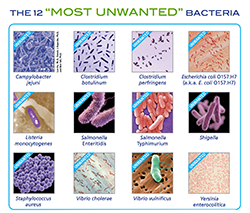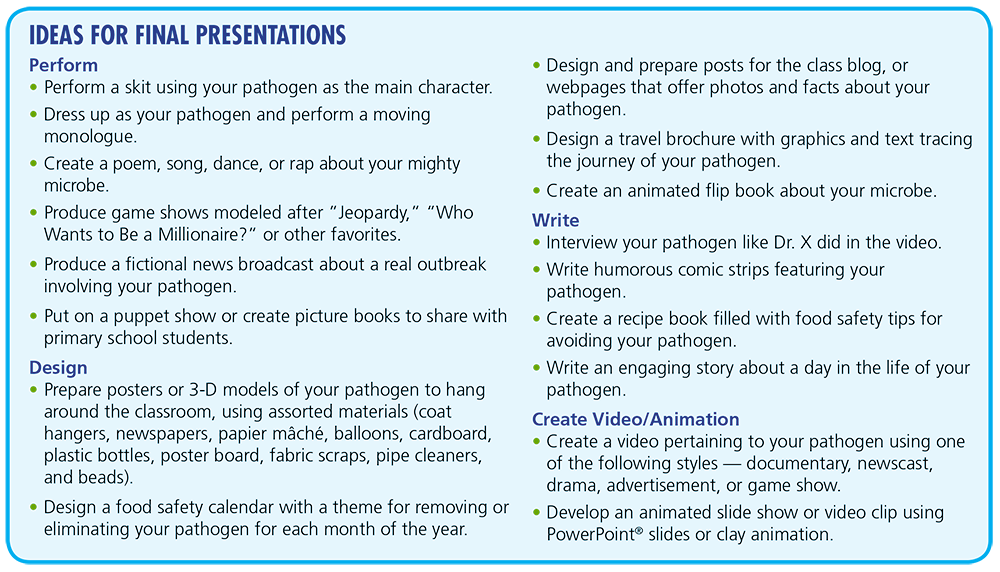Agricultural Literacy Curriculum Matrix
Companion Resource

The 12 Most Unwanted Bacteria
Students will divide into teams and select a bacterium from The 12 Most Unwanted Bacteria handout to research. Each team will create a food safety portfolio and conduct an innovative presentation. Each team will be able to recognize the foodborne illness that the bacterium causes and understand how to control that bacterium.
Time to Complete
Materials
For the Class
- A bowl containing the names of The 12 Most Unwanted Bacteria
- Foods, pictures, or models of foods that contain good bacteria, such as cheese and yogurt
For Each Team
- A food safety portfolio for recording research data (use a notebook or folder)
- An assortment of items for final presentations
- Copy of background information for their chosen bacterium from the Food Safety A to Z Reference Guide
- Copy of The 12 Most Unwanted Bacteria reproducible for each student
Advance Preparation
- Write the name of each bacterium from The 12 Most Unwanted Bacteria reproducible on separate pieces of paper and place them in a bowl. Teams of students will randomly select a bacterium to study throughout the unit.
- Copy the background material for each of the 12 Most Unwanted Bacteria from the Food Safety A to Z Reference Guide
- Make one copy of The 12 Most Unwanted Bacteria reproducible for each student.
- Collect actual foods, pictures, or models of foods that contain good bacteria (e.g., cheese, yogurt, etc.)
- Set a due date for the final team presentations.
Procedures
Introduction:
Ask students, "What do you usually see on a “Most Wanted” list?" Hopefully, students will respond with “bad guys” or “criminals.” Then hold up a copy of The 12 Most Unwanted Bacteria reproducible and ask, "Does anyone know why these are “unwanted?” (They’re pathogens that can be found in foods and can make us sick if we eat them.) Distribute the reproducible. Continue the discussion with:
- "Are any of these familiar to you? Which ones? What have you heard about them?"
- "Are all bacteria bad?" (No – in fact, most bacteria are beneficial to us in our everyday lives.)
- "If I asked you to make a poster of “Wanted Bacteria,” what would you put on that poster?"
- "Have you ever eaten foods that contain bacteria?"
- "Have you ever eaten this? (Show a picture or a slice of cheese, and/or a container or picture of yogurt.) What do these foods have in common? (They all contain beneficial bacteria.) Can you think of some other foods that contain good bacteria?" (Some examples: buttermilk, sauerkraut, pickles — even wine and beer.)
- "Are you surprised that these foods contain bacteria? Why?"
- "Where else might we find good bacteria?" (Examples could include: In our small intestine there’s generic E. coli, which helps us digest our food; and in antibiotics like Streptomycin, which helps treat patients with infections.) Explain to the class, "In this activity we’re going to focus on some harmful bacteria that can make us sick, and explore why Dr. X considers these bacteria to be the worst — “the baddest of the bad!”
Activity:
- Divide students into 12 teams. Have a person from each team select a pathogen from the bowl.
- Ask the students what they’d like to know about bacteria in order to become “super science detectives.” Write their answers on the board.
- Give a blank food safety portfolio to each team. Challenge them to be constantly on the lookout for information about their pathogen and to record their findings in their portfolio. Remind them to include the date, URL for websites, title, author, year, and page numbers of books or articles.
- Have each team divide the questions on The 12 Most Unwanted Bacteria handout equally among members of their team, so that everyone in the group has a task. The reproducible can be used as a checklist during their research.
- Give each team background material on their selected pathogen from the Food Safety A to Z Reference Guide to get them started.
- Explain that students in each group will work together to conduct in-depth research about their pathogen to find the following information:
- Find out how their pathogen makes an impact on food safety along the Farm-to-Table Continuum.
- Discover what can be done to control the growth of their pathogen.
- Present their research to the class to teach other students about their pathogen. Give students a date for their presentations.
Planning the Final Presentations
- Explain to the class that at the end of the food safety unit (or lesson), each team will present their research to the class in a fun, creative way. Each presentation should be a maximum of 5 minutes. Students can use the suggestions below or come up with their own ideas.
- Since one of the purposes of the presentation is to share what they learned about their bacterium with the other students, each team should prepare a simple fact sheet on their bacterium for the other teams to add to their portfolios. At the end of the presentations, each team will have information on all of the 12 Most Unwanted Bacteria.

Concept Elaboration and Evaluation
A pathogen is any microorganism that is infectious and causes disease. There are bad bacteria (pathogens), such as the 12 Most Unwanted Bacteria, that cause foodborne illness. However, not all bacteria are bad. Good bacteria, such as those found in foods like yogurt and pickles and those in antibiotics like Streptomycin, are helpful to us.
Note to Teacher
This activity is part of a complete module covering food safety. You can find each lesson on the Matrix using the links below.
File, Map, or Graphic
Author
Organization
Sources
The Science and Our Food Supply Curriculum was brought to you by the Food and Drug Administration Center for Food Safety and Applied Nutrition and the National Science Teachers Association.
- FDA Education Team Leader Food Safety Initiative: Marjorie L. Davidson
- FDA Science and Our Food Supply Project Director: Louise H. Dickerson
- FDA/NSTA Associate Executive Director and Science and Our Food Supply Program Director: Christina Gorski
- FDA/NSTA Science and Our Food Supply Program Assistant: Jill Heywood
Lessons Associated with this Resource
- Blue's the Clue: Souring Milk for Science (Grades 6-8)
- Chain of Food (Grades 6-8)
- Cooking Right: The Science of Cooking a Hamburger (Grades 6-8)
- Crossed Up!
- Hands Off, Bacteria!
- Mystery Juice (Grades 6-8)
- Supermarket Smarts
- Ultra High Pressure Treatment (Grades 6-8)
- Understanding Bacteria (Grades 6-8)
- Chain of Food (Grades 9-12)
- Ultra High Pressure Treatment (Grades 9-12)
- Blue's the Clue: Souring Milk for Science (Grades 9-12)
- Mystery Juice (Grades 9-12)
- Understanding Bacteria (Grades 9-12)
- Food Safety Sleuths- Food Safety Specialist
- A Chilling Investigation
